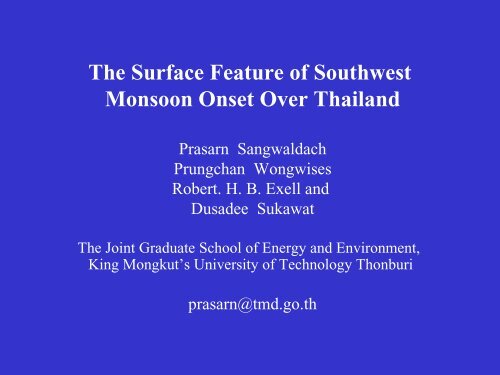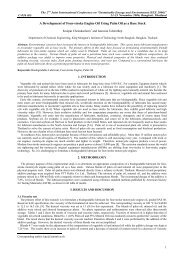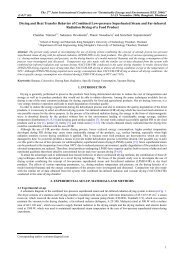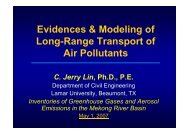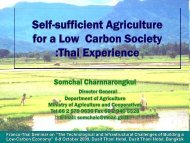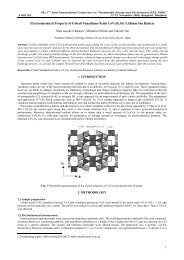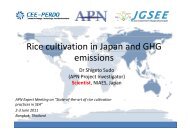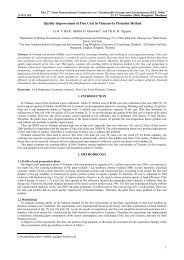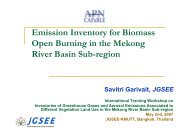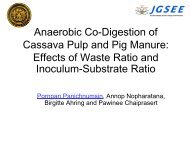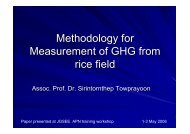The Surface Features of Southwest Monsoon Onset over Thailand
The Surface Features of Southwest Monsoon Onset over Thailand
The Surface Features of Southwest Monsoon Onset over Thailand
- No tags were found...
Create successful ePaper yourself
Turn your PDF publications into a flip-book with our unique Google optimized e-Paper software.
<strong>The</strong> <strong>Surface</strong> Feature <strong>of</strong> <strong>Southwest</strong><strong>Monsoon</strong> <strong>Onset</strong> Over <strong>Thailand</strong>Prasarn SangwaldachPrungchan WongwisesRobert. H. B. Exell andDusadee Sukawat<strong>The</strong> Joint Graduate School <strong>of</strong> Energy and Environment,King Mongkut’s University <strong>of</strong> Technology Thonburiprasarn@tmd.go.th
Outline• Background• Methodology• Numerical Simulation• Conclusion
Background1. Schematic <strong>of</strong> the southwest monsoon- <strong>The</strong> monsoon is a seasonal wind.- persistent winds with seasonal change in direction incertain local areas, duration and periods every.- results from thermodynamic difference between thesea and continent.Jay S. Fein and Pamela L. Stephens (1987), <strong>Monsoon</strong>s
Background (continue)2. Asian southwest monsoon- <strong>The</strong> Siberian plateau is now warmer than the seas.- <strong>The</strong> winds blow from from high pressure areas in the seato the low pressure areas or warm cyclone in the continentLLHJay S. Fein and Pamela L. Stephens (1987), <strong>Monsoon</strong>s
Background (continue)- <strong>The</strong> agriculture in <strong>Thailand</strong> are favored by thetropical monsoon climate- Some studies are shown that the meteorological elementshave significant effects on the onset process.a) <strong>The</strong> monthly mean surface air temperaturesexceed 33-35°C in the land areas <strong>of</strong> northwest Indiaand adjoining areas (Joshi,1990)b) <strong>The</strong> progressive development <strong>of</strong> heat lows before andduring the monsoon onset is the major causative factors<strong>of</strong> the Indiansummer monsoon circulation (Rao, 1976)c) Through extends from the sea level to 500 hPa(Keshavamurty, 1970)
Questions1. How to indicate the onset date.2. How the meteorological parameters change duringthe monsoon onset period.3. What are meteorological parameters which the mostimpact to southwest monsoon onset in <strong>Thailand</strong>.
MethodStartData collectionPlot selected parametersECMWFTMDEvaluate outputAnalysis andselect monsoon<strong>Onset</strong> dateResult discussionConclusionRun MM5 Model
<strong>The</strong> southwest monsoon onset<strong>of</strong>ficial definition <strong>of</strong> TMD.- <strong>The</strong> low-level wind direction change to Southor <strong>Southwest</strong> component- <strong>The</strong> upper wind direction must change fromWest to East component- <strong>The</strong>re are continuous 3 rainy-days in the period <strong>of</strong>5 days and not less than 5 mm in each day and thecumulate rainfall in the period must not less than25 mm.
Problems• Not suitable for real time forecasting.• Can not use in case <strong>of</strong> abnormal rainfall(heavy rainfall, tropical cyclone, etc.)• Try to use dynamical parameters from NWP Model.• Can use the parameters from the existing forecastingmodel (MM5, TMD, ECMWF).
<strong>Southwest</strong> <strong>Monsoon</strong> <strong>Onset</strong> Date in MayArea 1996 1997 1998 1999 2000Upper <strong>Thailand</strong> 7 18 17 4 15<strong>The</strong> periods <strong>of</strong> this study- case 1 1-14 May 1996,- case 2 11-25 May 1997,- case 3 10-24 May 1998,- case 4 28 April - 10 May 1999, and- case 5 8-22 May 2000.
<strong>The</strong> result interested parameters1.<strong>Surface</strong> air temperature2.Sea level pressures3.<strong>Surface</strong> relative humidity4.<strong>Surface</strong> sensible heat flux5.Wind field at 850, 500 and 200 hPa6.Vertical relative humidity* <strong>The</strong> results show only sample in 1996 but the otheryears are reasonable
Wind fields at 850 hPaAt 00 UTC on 2/5/1996 At 00 UTC on 7/5/1996At 00 UTC on 12/5/1996
Wind fields at 500 hPaAt 00 UTC on 2/5/1996 At 00 UTC on 7/5/1996At 00 UTC on 12/5/1996
Wind fields at 200 hPaAt 00 UTC on 2/5/1996 At 00 UTC on 7/5/1996At 00 UTC on 12/5/1996
<strong>Surface</strong> relative humidity (%)At 00 UTC on 2/5/1996 At 00 UTC on 7/5/199680-85 %80-90 %At 00 UTC on 12/5/199685-95 %
Vertical relative humidityAt 00 UTC on 2/5/1996 At 00 UTC on 7/5/199690 %500-100 hPa90 %1000-700 hPa90 %1000-700 hPa90 %1000-700 hPaAt 00 UTC on 12/5/199690 %1000-700 hPa90 %1000-700 hPa90 %1000-700 hPa
<strong>Surface</strong> air temperature (°C)At 00 UTC on 2/5/1996 At 00 UTC on 7/5/199628-29 °C30 °CAt 00 UTC on 12/5/199627-29 °C
Sea level pressure (hPa)At 00 UTC on 2/5/1996 At 00 UTC on 7/5/19961008-1010 hPa1009-1010 hPaAt 00 UTC on 12/5/19961009-1011 hPa
<strong>Surface</strong> sensible heat flux (W/m 2 )At 00 UTC on 2/5/1996 At 00 UTC on 7/5/1996100-200 W/m 2100-300 W/m 2 100-200 W/m 2At 00 UTC on 12/5/1996
Comparison <strong>of</strong> model RMSE values withWMO Standards.Root mean square error <strong>of</strong> 1996 1997 1998 1999 2000 2002Limits forerrors<strong>Surface</strong> air temperature (°C) 1.36 0.93 1.49 0.97 1.02 1.16 4 °CSea level Pressure (hPa) 0.43 1.22 1.51 0.43 0.42 1.78 2hPa<strong>Surface</strong> relative humidity(%)1.74 1.52 1.59 1.72 1.69 1.44 15%
Conclusion• <strong>The</strong> surface air temperature, sea level pressure, andsensible heat flux were the most important indicators <strong>of</strong>the monsoon onset <strong>over</strong> <strong>Thailand</strong>.•<strong>The</strong> surface air temperature and sensible heat fluxincreased before and during the monsoon onset, and fellduring the period after the monsoon onset.Temperature Sensible heat fluxTemperatureSensible heat fluxTemperature (?C)30.53029.52928.52827.5271 2 3 4 5<strong>Onset</strong> periodSensible heat flux (W/m2)3503002502001501005001 2 3 4 5<strong>Onset</strong> period
Conclusion (continued)• <strong>The</strong> sea level pressure and surface relative humidityincreased before and during the monsoon onset, and werestationary during the period after the monsoon onset.•<strong>The</strong> vertical relative humidity and wind field at 850 hPa,500 hPa and 200 hPa were the major characteristics <strong>of</strong> thesouthwest monsoon throughout the period.Sea level pressure Relative humiditySea level pressureRelative HumiditySea level pressure (hPa)1012101110101009100810071006Relative humidity (%)100959085807510051 2 3 4 5701 2 3 4 5<strong>Onset</strong> period<strong>Onset</strong> period
Conclusion (continued)•<strong>The</strong> vertical relative humidity and wind field at850 hPa, 500 hPa and 200 hPa were the majorcharacteristics <strong>of</strong> the southwest monsoonthroughout the period.
<strong>The</strong> proposal for new monsoon onsetdefinition for <strong>Thailand</strong>ParametersBefore the monsoononsetDuring the monsoononsetAfter the monsoon onset<strong>Surface</strong> air temperature °C 28-29 30
Acknowledgments• This work was supported by the Joint Graduate School <strong>of</strong>Energy and Environment, King Mongkut’s University <strong>of</strong>Technology Thonburi.• Special thanks are <strong>of</strong>fered to the European Center forMedium Range Weather Forecasting (ECMWF) andThai Meteorological Department (TMD) for data supportedand Penn State/NCAR for (MM5) version 3 model anddocuments.
Thank you for your attention


